NO TIME TO DIE Countdown: LICENCE TO KILL Revisited
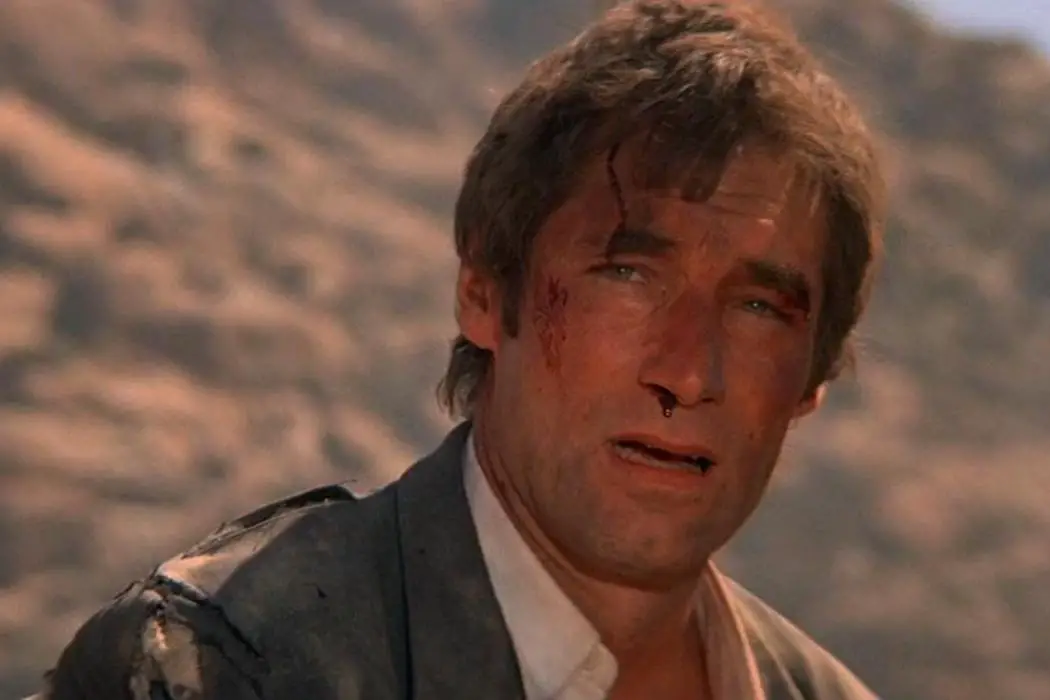
Movie lover & Los Angeles-based writer. BA in Film Criticism…
In the No Time To Die Countdown, Jake Tropila takes a look back at every Bond film – official and unofficial – in anticipation of the release of the latest entry
The Living Daylights was a resounding success, even if contemporaneous audiences of 1987 couldn’t quite warm to Dalton’s cool touch. No matter; the film’s reputation has only improved over time, often regarded as establishing the framework perfected in the Craig era (you could even say Dalton walked so Craig could run). And while Dalton’s take was undeniably darker, the film still very much retained the DNA of Bond, never once losing sight of the mission. Broody, but elegant; gritty, but classy; intricate, but unwavering. The big question mark remained: where would this Bond go from here?
Licence to Kill is a different beast entirely. Violent, barbaric, and untamed — this was everything that James Bond decidedly was not. It was here that Dalton’s ideal of Fleming’s agent crystallized: gone were the days of leaping across the backs of alligators to safety, or goofy pigeons doing double-takes as a gondola turned into a hovercraft. This one also offers a bold shake-up of the genre, too. Classic spy games were out; Miami Vice was very much in. The trajectory had been altered. Everybody, strap in for a hard-edged tenure. This is now what Bond was now going to be.
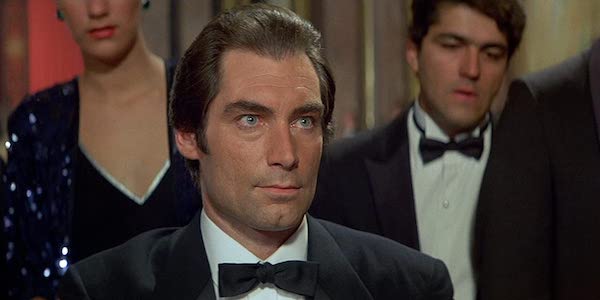
Except that it wasn’t. The dream did not continue after this entry. For theatrical audiences, this particularly nasty installment was definitely not what they were looking for in the breezy summer of ’89 (adjusted for inflation, Licence to Kill is the lowest-grossing film in the franchise). EON’s parent company ran into rights issues when it came to splitting up the company, and Dalton would eventually relinquish the role, despite having initially signed on for a multi-picture contract. What could have been a promising run of quality films only managed to double the output of George Lazenby.
Shame, really. Audiences back then didn’t know how good they had it. The fact of the matter is Licence to Kill is incredible. A vicious, knock-down-drag-out bruiser of a feature, this is the Bond film that eschews everything the franchise is known for a pared-down tale of revenge. It also represents Bond at his very best. It’s 1989. Climb aboard my tanker truck, friend. We’re going to hell and back, and Dalton‘s just the man to take us there.
Going straight for your heart
Felix Leiter’s getting married! It’s an exciting day for everyone’s favorite CIA Agent (played here by David Hedison, reprising his role as Felix #5 from Live and Let Die), but the nuptials with Miss Della will have to wait — drug lord Franz Sanchez has just rolled into town, and the DEA (plus Bond) are determined to take him down. Meanwhile, Sanchez pays a visit to his lover, Lupe, who is found in bed with another man. Sanchez orders his heart removed before whipping Lupe’s back with a barbed stingray tail. Ouch.
The action in Licence to Kill is immediately punchier than many of its predecessors. This isn’t necessarily a complaint; I love how the film hits the ground running, and stuntwork is consistently marvelous throughout. Chalk it up to the fine work of director John Glen, returning for his fifth and final entry (more than any other Bond director) to date. Glen has cited Licence to Kill as his favorite of the Bond’s he helmed. Between this and The Living Daylights, it’s a helluva note to go out on.
Speaking of marvelous stuntwork: the capture of Sanchez, which finds Bond utilizing the cable from a coast guard helicopter to capture and reel in the drug lord’s escape plane, is nothing short of extraordinary. The Living Daylights’ grand finale set a new bar for a mid-air battle utilizing actual aircraft; Licence to Kill immediately tops it. Bonus points for neatly tying everything back to Felix’s wedding. After skydiving to safety, the ceremony can begin. Bond and Felix’s parachutes becoming makeshift wedding trains is a touch I love.
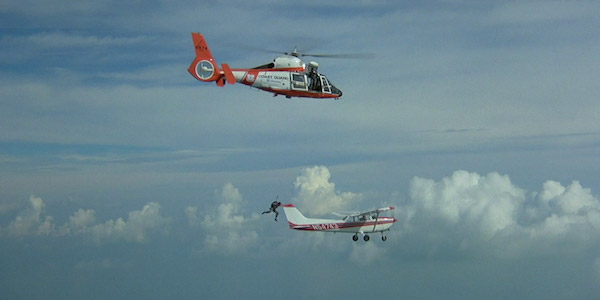
Here’s a theme song I have trouble defending. Following two bona fide bangers, Gladys Knight’s title track fails to muster much excitement, I’m afraid. I can’t quite put my finger on why — something about the brassiness of 60s’ Bassey filtered through the R&B of the 80s (Die Hard composer Michael Kamen also did the score for this film) and the awfully too-on-the-nose lyrics (“Got a licence to kill / And you know I’m going straight for your heart”) make this one very much Not For Me. I don’t hate the song; it just feels like a rare miss, considering how many of these I enjoy.
What is definitely not a miss is Maurice Binder’s opening title sequence, which would also turn out to be his last. Having contributed to every Bond film since the series’ inception (save for two, From Russia with Love and Goldfinger), Binder’s achievements are very much etched into cinematic history — often imitated, never duplicated. Recent examples that try to emulate these sequences (David Fincher’s Dragon Tattoo, Guy Ritchie’s Wrath of Man) fall completely flat for me. It must be the CGI-ness of modern versions, which feel cold and sterile; when it came to outrageous neon lighting, groovy optical effects, and dancing silhouetted ladies, nobody did it better than Binder.
Actually, we bid farewell to a lot of series stalwarts with this entry. Robert Brown, while not quite Bernard Lee, made a very agreeable M in just four films. I neglected to mention in my Living Daylights piece that we had a new Miss Moneypenny, played by Caroline Bliss, who stuck around as long as Dalton did. She’s not without her charms, but like her corresponding 007, I’d love to have seen more of her. And lastly, we bid farewell to Cubby Broccoli, who has produced his final film before turning the reins over to his daughter, Barbara. I would not be writing this piece if it weren’t for his valiant efforts. So, thank you, Cubby. Thank you for your service.
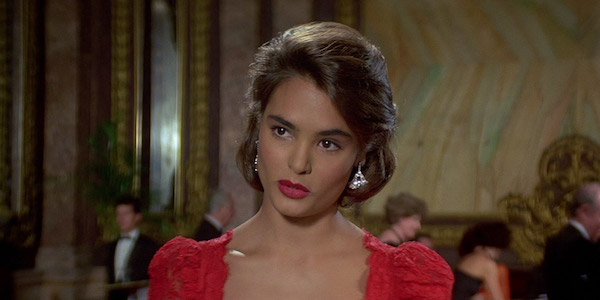
Back to the action. Obviously, Sanchez won’t remain captured for long — corrupt agent Killifer sees to that. As I watched Sanchez’s escape, I couldn’t help but observe how his underwater rescue (prompted by Killifer driving the cube truck both were occupying off a bridge into the ocean) reminded me of Sean Harris’ breakout in Mission: Impossible – Fallout, complete with water flooding the rear compartment. The aforementioned pre-title sequence and mid-air plane capture clearly influenced Christopher Nolan (a self-proclaimed Bond fan) to try and do the same thing in the opening for The Dark Knight Rises. And Bond’s later close encounter with a great white shark? Ace Venture: Pet Detective, obviously.
Joking about that last one, of course, but the fact remains: Bond’s influence still reaches far and wide, even if the influences derive from the unlikeliest of places. It’s extremely heartening to see modern blockbusters cull from one of the greats, especially if it was a late-80s Bond film that was almost universally hated upon its initial release.
With only two films under his belt, Dalton’s entries inevitably become an exercise in “compare and contrast.” While my preference for which film I like more frequently oscillates (seriously, I can never land on a favorite), I can definitively assert where Licence to Kill has a leg up from The Living Daylights: Franz Sanchez. This Bond Villain handily mops the floor with the Koskov/Whitaker duo seen in the previous film, and I would even go so far as to say he deserves to sit with Auric Goldfinger and Francisco Scaramanga at the Legendary Big Bad’s table.
But why? There’s no grand scheme to speak of, no grandiose plans to conquer the world. No disfigured henchmen or special killing machines. What makes Sanchez so special? The beauty is in his simplicity. Sanchez simply wants to be the best in his field and makes no qualms about how he goes about it. Plus, his greatest trait is that he rewards loyalty more than anything else; there is a brotherly bond between him and his crew that is rarely seen in the world of Bond. And Robert Davi is just fantastic in the role, oozing rich layers of charisma while still capable of turning completely menacing on a dime. A top-tier Bond Villain.
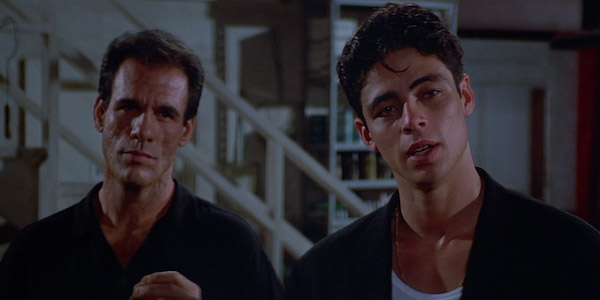
The Leiter Wedding is a pleasant affair. Della is a bubbly presence, sneaking in extra smooches on Best Man Bond, while Felix can’t seem to pull himself away from work long enough to enjoy himself. Their gift to Bond is rather sweet (a genuine Felix Lighter!) and the film makes a rare reference to the late Tracy Bond. The sting in Dalton’s voice as he politely refuses the garter is palpable.
Unfortunately for Felix, his arrest of Sanchez didn’t sit well with Sanchez, so his evening of celebration is cut horrifically short. Aided by a baby-faced Benicio Del Toro as sinister, knife-wielding henchman Dario, Della is raped and murdered (“We gave her a nice honeymooooon”), and Felix is fed to a pit of sharks. Licence to Kill isn’t directly based on a Fleming title, but a lot of its details are pulled from Live and Let Die, which was the second novel written, and is the likeliest explanation for Hedison returning to the role.
Felix barely survives, discovered by Bond on the brink of death, with a crude note pinned to him that reads “He disagreed with something that ate him” (this is also pulled straight from the Live and Let Die novel). Bad move, Sanchez. Bad move.
More of a Problem Eliminator
The series has teased Bond going rogue before, but this is the first film that commits to him going full-on renegade for nearly the entire duration of the proceedings. Fleeing M’s capture (“Your licence to kill has been revoked!”), Bond finds himself truly on his own here, dodging Sanchez’s men and navigating a foreign territory he knows nothing about. The propositions seem grim, especially for a man who rarely finds himself alone.
Except he’s not alone. Enter Pam Bouvier, DEA agent, ex-army pilot, and all-around badass. Pam makes for a terrific ally, and Carey Lowell more than holds her own against the steely Dalton. Intelligent, resourceful, and progressive (“Why can’t you be my secretary?” she demands, rightfully insulted at hers and Bond’s cover story), Pam is the kind of gal who brings a shotgun to a bar fight. As far as Bond Ladies go, she’s secretly one of the best.
But who ends up stealing the film? In Bond’s darkest hour, that honor goes to the avuncular Q, handed his meatiest role in the entire franchise. While often relegated to a single scene in his lab (“Now, pay attention, etc.”) Q gets to enjoy some fieldwork for a change, offering much-needed assistance in these dire times. For a film where a man’s head explodes in a depressurization chamber, Q remains an absolute delight, enjoying some extended time onscreen with Dalton and never once feeling incongruous to the plot. God bless that kindly and irascible old man.
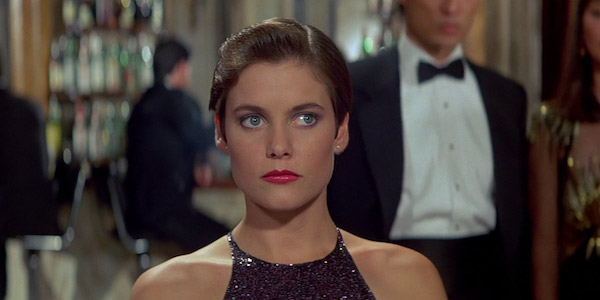
The exploding head belongs to Milton Krest, operator of Sanchez’s marine unit and essentially his second-in-command. When Bond infiltrates Krest’s operation at night, he encounters Lupe, still wounded from her brutal punishment at the hands of Sanchez. Lupe is a fascinating character. The Villain Girl is a recurring trope, one who starts out on the wrong side and either helps Bond defeat the Villain to get promoted to Bond Girl (Pussy Galore in Goldfinger, Domino in Thunderball) or is killed to establish how evil the Villain truly is (Andrea Anders in The Man with the Golden Gun). Here, not only does Lupe survive, but she proves to be stronger than the man she was paired up with. A real warrior.
Bond’s excursion on Krest’s yacht leads to another thrilling setpiece. Evading armed guards, Bond dives to the bottom of the ocean, absconding with one henchman’s scuba gear as he knifes a bunch of Sanchez’s products and escapes via some exciting water ski maneuvers while connected to a seaplane. Absolutely no complaints here; Glen calibrates everything to maximum exhilaration.
Rather than storm Sanchez’s compound with guns blazing, Bond surreptitiously infiltrates the drug lord’s criminal empire and systematically dismantles it from within. The strongest moments in Licence to Kill pit Dalton and Davi against each other, with the latter completely unaware that he’s going to be destroyed by the former. During their first meeting, Sanchez inquires about the gun Bond carries, and this immortal exchange is shared between two killers:
BOND: In my business, you prepare for the unexpected.
SANCHEZ: And what business is that?
BOND: I help people with problems.
SANCHEZ: Problem solver?
BOND: More of a problem eliminator.
Magnificent.
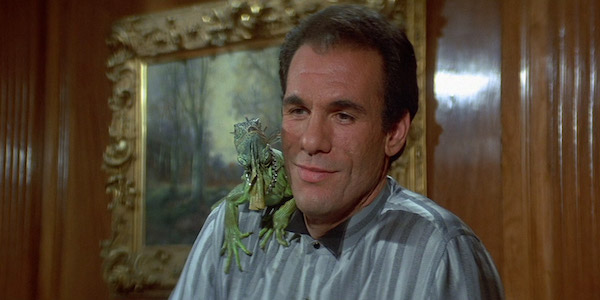
The bulk of the runtime is devoted to glorious acts of vengeance. One goon is dumped into a drawer of flesh-eating maggots. Another meets his demise in the tank of an electric eel. Killifer is fed to the same sharks who mangled Felix. When Sharkey, a wonderfully Quarrel-esque ally, meets his unfortunate demise at the hands of one of Sanchez’s men, Bond returns the favor with a speargun to the killer’s chest.
Oh yeah, and then there’s that head explosion. Much of Bond’s plot revolves around him stealing millions of dollars of Sanchez’s money and then planting it on Sanchez’s associates to make the Villain think he’s employed a bunch of turncoats. Murder then ensues. By playing the part of Sanchez’s ally, Bond effectively plants the seeds of doubt in the villain’s mind and watches the chaos unfold before him. It’s a rather brilliant approach that makes for increasingly satisfying outcomes.
Admittedly, there are some bizarro elements in Licence to Kill that I forget about every time I watch the movie. Sanchez is doing business with televangelist cult leader Professor Joe Butcher, played by Wayne Freakin’ Newton, who uses his program as a front for selling Sanchez’s drug wares. And Sanchez turns out to be under surveillance by Hong Kong police, who disguise themselves as ninjas to foil Bond’s assassination attempt. And don’t get me started on the creepy fish statues.
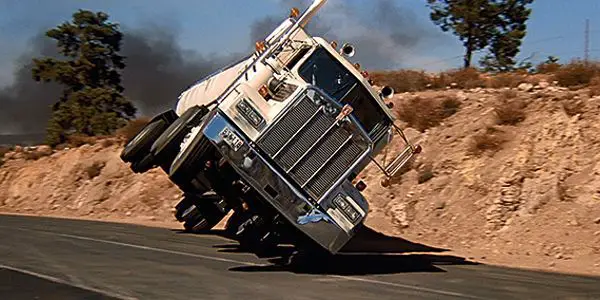
Strange detours, to be sure, but Licence to Kill never loses its way and saves its best stuff for last, climaxing with an extended action finale that commences with the destruction of Sanchez’s drug lab and ends with an epic chase sequence. The drug lab offers more grisly deaths – Dario is shredded in a cocaine brick grinder, and Heller, another of Sanchez’s men, is impaled on a forklift – before descending down the side of a mountain in tanker trucks.
(I suppose I never did mention Sanchez’s ultimate scheme—not that it matters—but his plan is to sell cocaine that has been submerged in gasoline to his buyers, so that it may travel internationally without being detected, and through the magic of science, they will be able to separate the powder from the liquid. The gasoline is a bonus obtained from the purchase. Sure, why not).
The tanker chase is John Glen’s finest hour. The practical mayhem on display is stupendously orchestrated: Bond shifts his tanker to drive on its left-hand side wheels to avoid a stinger missile, streams of gasoline ignite into deadly trails of fire, Pam provides air support from the sky. Best of all: Sanchez is engulfed in a blazing inferno, thanks to the lighter Felix gifted to Bond. It all circles back to the beginning.
Conclusion: Licence to Kill
I always get a little sad towards the end of Licence to Kill, knowing that this is Dalton’s final stop with the franchise. It felt like he was just getting started, but at least he found a way to go out on top. Bond actors tend to overstay their welcome, or they are cut off before their prime (time will tell where Craig lands with No Time to Die). Dalton is the exception. With The Living Daylights and Licence to Kill, he delivered a perfect run with the series. While I can’t deny I’d love to have seen more, I’m extremely grateful that we got the two that we did. They don’t come better than this.
Coming up next: Say hello to Bond Number Five. The No Time To Die Countdown will return with Goldeneye.
What do you think? Did Timothy Dalton have a perfect run of movies? Let us know by sharing your thoughts in the comments below.
Watch Licence to Kill
Does content like this matter to you?
Become a Member and support film journalism. Unlock access to all of Film Inquiry`s great articles. Join a community of like-minded readers who are passionate about cinema - get access to our private members Network, give back to independent filmmakers, and more.
Movie lover & Los Angeles-based writer. BA in Film Criticism & Media Theory from CSU Northridge. Unofficial Bond ally. Rhymes with “tequila.”













